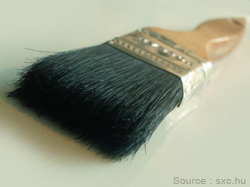A new paint job can do wonders for any room. If your paint is chipped, peeling, or scuffed up, it can cheapen the look of your home's interior. A change in color can also completely change the mood and even the sense of space in a room. If you plan on painting or repainting a room, preparation is key. Read this guide to see the steps for preparing a room to be painted and some painting tips as well.
Preparing the Room

The first thing you'll want to do is make sure that nothing gets damaged in the process of painting. Move any furniture you can out of the room for the duration of the job, and any that you can't move you should place in the center of the room. If there is still danger of things getting paint or dust on them, cover them with a plastic or canvas tarp. Use painter's tape to secure the covering.
Before you do any sanding, you should start taping; the dust from the sanding will make it difficult for the tape to adhere later. Tape anything that is not detachable (e.g., doorknobs). If you are painting the walls, tape the trim. If you are painting the trim, tape the walls. Remove outlet covers and light fixtures, if possible. If you plan on painting these the same color as the walls, you should do it separately anyway. Make sure you keep track of any screws or other hardware for easy installation later.
Lay down drop cloths to protect your floors from dust and pain, at least four feet out from each wall. Canvas, old blankets, and plastic tarps are all acceptable for this job, so long as they don't have holes in them.
Depending on the look of your walls, you may need a light sanding or a more heavy-duty one. Large patches of chipped paint will show from beneath the new coats. Sand so that you can feather the chipped areas into a smooth finish by starting with rough-grain sandpaper and working your way down to a finer grain. If the damage is severe, consider stripping the paint and starting fresh.
Small holes can be filled with joint compound and sanded after drying. For fixing larger holes, read one of our guides on the subject.
If you are painting over an old coat of paint, give it a light sanding before you start painting; this will help the new coat to bond better. If you are starting on untouched wood or drywall, prime the area you wish to paint first.
Large areas are most easily taken care of with rollers, and you can use brushes to take care of detail work near trim and around fixtures. Make sure all the brush strokes in a section are going the same way, or it will produce an undesirable look.
Painting is mostly about prepping really well; the process of putting the paint on the wall is not as difficult as setting things up so that you can make mistakes and not pay too dearly for them. Put some music on, find some old jeans, and have fun changing the color of those walls!